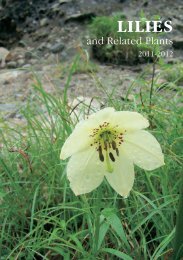LILIES - RHS Lily Group
LILIES - RHS Lily Group
LILIES - RHS Lily Group
You also want an ePaper? Increase the reach of your titles
YUMPU automatically turns print PDFs into web optimized ePapers that Google loves.
villages. These include Scilla sibirica, Paeonia tenuifolia, Tulipa gesneriana,<br />
T. biebersteiniana.<br />
As well as the wild bulbous plants, local people grow many introduced Liliaceous<br />
and related plants. We observed and checked in private gardens several species<br />
of tulips (Tulipa gesneriana, T. praestans Hoog), several species of lilies (Lilium<br />
regale E.H. Wilson, L. lancifolium Thunb., L. bulbiferum L.)and other related<br />
plants: Hemerocallis fulva (L.) L., H. lilio-asphodelus L., Hyacinthus orientalis L.,<br />
Gladiolus x cultorum hort., Narcissus poeticus L., N. pseudonarcissus L. etc.<br />
The introduction to the Khoper area takes place spontaneously and accidentally,<br />
because scientific centres, such as botanical gardens, arboreta or specialized<br />
nurseries are absent. As a result, the assortment of bulbs and other related<br />
liliaceous plants is rather poor although Cossacks like to decorate their yards with<br />
flowers. A severe climate is also a limiting factor and does not encourage further<br />
introduction of more exotic species of bulbs which would not withstand the cold<br />
winters without digging up which makes cultivation more difficult.<br />
There is much to do<br />
As it was mentioned earlier, the flora of the steppe of southern Russia is under<br />
increasing threat from man. Due to intensive animal breeding and ploughing up of<br />
virgin steppe for agriculture, as well as the complete forestation of sands in recent<br />
decades, the number of threatened plant species has increased considerably.<br />
At the same time the area of the lower reaches of the Khoper River differs<br />
from many other steppe territories by the survival of primary virgin steppe. That<br />
is why more than 35% of species included in the Red Data Book of the Volgograd<br />
region occur here, this is a most special area for nature in the whole of the Lower<br />
Volga region.<br />
Botanically this territory is poorly investigated, and there are not many<br />
specimens in the leading herbaria of Russia from this territory. Our field research<br />
of the last years has enlarged our knowledge of this flora, and many herbarium<br />
specimens have been collected (about 8,000 sheets). In 2005-2006 with the help<br />
of a Rufford Small Grant (Project 41.01.05) four botanical expeditions at different<br />
times of the growing season were organized to the place for the purpose of<br />
examining the threatened flora and updating the general list of plants. At present<br />
together with Prof. V.A. Sagalaev, we have been compiling the Flora of the Lower<br />
Khoper Nature Park. Many species have not yet been introduced to cultivation,<br />
which is an important task for the future. There is an urgent need to conserve<br />
plants of the Russian steppe in their natural habitat and to protect them for future<br />
generations. There hope that the Nature Park “Nizhnekhopersky” will play an<br />
important role in the conservation of steppe plants and in educating people to<br />
love nature.<br />
121




